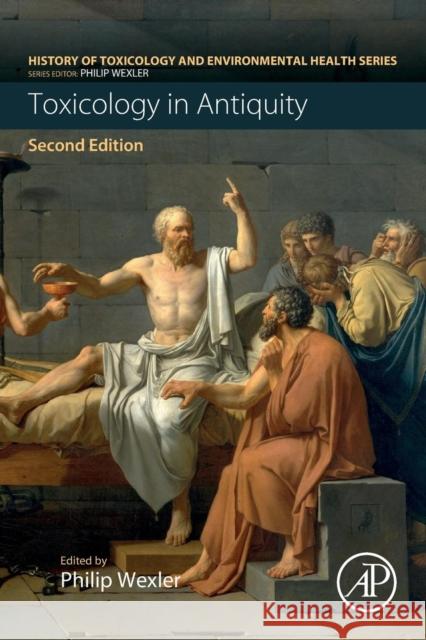Toxicology in Antiquity » książka



(netto: 450,56 VAT: 5%)
Najniższa cena z 30 dni: 473,09
ok. 30 dni roboczych
Dostawa w 2026 r.
Darmowa dostawa!
1. The Prehistory of Poison Arrows 2. Beetle and Plant Arrow Poisons of the San People of Southern Africa 3. Toxicology in Ancient Egypt 4. The Death of Cleopatra: Suicide by Snakebite or Poisoned by Her Enemies? 5. Kohl Use in Antiquity: Effects on the Eye 6. Nicander, Thêriaka, and Alexipharmaka: Venoms, Poisons, and Literature 7. The Case Against Socrates and His Execution 8. Murder, Execution, and Suicide in Ancient Greece and Rome 9. The Oracle at Delphi: The Pythia and the Pneuma, Intoxicating Gas Finds, and Hypotheses 10. Alexander the Great: A Questionable Death 11. Mithridates of Pontus and His Universal Antidote 12. Theriaca Magna: The Glorious Cure-All Remedy 13. The gates to hell in antiquity and their relation to geogenic CO2 emissions 14. Lead Poisoning and the Downfall of Rome: Reality or Myth? 15. Poisons, Poisoners, and Poisoning in Ancient Rome 16. Chemical and Biological Warfare in Antiquity 17. Asclepius and the Snake as Toxicological Symbols in Ancient Greece and Rome 18. Anthropogenic Air Pollution in Ancient Times 19. Poisoning in Ancient Rome: Images and Rules 20. "Gleaming and Deadly White: Toxic Cosmetics in the Roman World 21. Cherchez la femme: three infamous poisoners of ancient Rome 22. Did Hannibal really poison himself? 23. Drugs, Suppositories, and Cult Worship in Antiquity 24. Entheogens in Ancient Times: Wine and the Rituals of Dionysus 25. Entheogens (Psychedelic Drugs) and the Ancient Mystery Religions 26. Ancient Mystery Initiation: Toxic Priestesses and Vaginal Communion 27. Harmful Botanicals 28. Pearl, an Ancient Antidote of Eastern Origin 29. Rhetoric, Demons, and the Poisoner's Tongue in Judaism and Early Christianity 30. Poisonous Medicine in Ancient China 31. Toxicity of Ayurvedic Medicines and Safety Concerns: Ancient and Modern Perspectives 32. Mushroom Intoxication in Mesoamerica
Philip Wexler has written and edited numerous publications related to toxicology and toxico-informatics, as well as taught and otherwise lectured globally on these topics. He has been Editor-in-Chief of Elsevier's Encyclopedia of Toxicology including the current, 4th edition (2023) since its inception as well as Information Resources in Toxicology (Elsevier. 5th ed. 2020), and Chemicals, Environment, Health: A Global Management Perspective (CRC Press/Taylor and Francis. 2011). He has served as Associate Editor for Toxicology Information and Resources for Elsevier's journal, Toxicology and edited special issues on Digital Information and Tools. Phil is also overseeing a monographic series on Toxicology History. Volumes have been published on Antiquity, the Middle Ages and Renaissance, modern clinical toxicology, risk assessment, alternative test methods, food and nutrition, and disasters, with more in the planning stages. He is a co-Editor-in-Chief of the Taylor and Francis journal, Global Security: Health, Science, and Policy and a past recipient of the US Society of Toxicology's (SOT) Public Communications Award.
Phil recently retired from a long federal career as a Technical Information Specialist at the National Library of Medicine's (NLM) Toxicology and Environmental Health Information Program, within its Specialized Information Services Division (SIS). His initial position at NLM was as a Fellow of its Associate Program and early work included a brief stint in the Reference Services Section. A recipient of the NLM Regents Award for Scholarly or Technical Achievement and the Distinguished Technical Communication Award of the Washington chapter of the Society for Technical Communication, he was team leader for the development of the ToxLearn online multi-module tutorials, a joint activity with the SOT. Phil had also been project officer for the LactMed file on drugs and lactation, and the IRIS (Integrated Risk Information System) and ITER (International Toxicity Estimates for Risk) risk assessment databases.
Additionally, Phil had been the guiding force behind, and federal liaison to, the World Library of Toxicology, Chemical Safety, and Environmental Health (WLT) prototype, a free global Web portal that provided the scientific community and public with links to major government agencies, non-governmental organizations, universities, professional societies, and other groups addressing issues related to toxicology, public health, and environmental health prior to its migration to the INND/Toxipedia group. This multilingual tool, fed by information from a roster of international Country Correspondents, has been praised as a successful test resource for overcoming barriers to the sharing of information between countries, enhancing collaboration, and minimizing duplication. Currently on hiatus, it awaits a visionary funding source to become operational.
A trustee of the Toxicology Education Foundation (TEF), Phil had previously served as its federal liaison. He is a past Chair of SOT's World Wide Web Advisory Team, and active in its Ethical, Legal, Forensics, and Social Issues Specialty Section. He was a member of the Education and Communications Work Group of the CDC/ATSDR's National Conversation on Public Health and Chemical Exposure. A co-developer of the Toxicology History Room, he is co-founder and was federal liaison to the Toxicology History Association. For many years he organized and emceed the popular Toxicology Quiz Bowl at the annual SOT meetings.
In addition to pursuing toxicology-related activities in his retirement, Phil is happy to have more time to embrace other lifelong interests. He is the author of five poetry collections, a mosaic artist, and a cactus and succulent enthusiast.
1997-2025 DolnySlask.com Agencja Internetowa
KrainaKsiazek.PL - Księgarnia Internetowa









